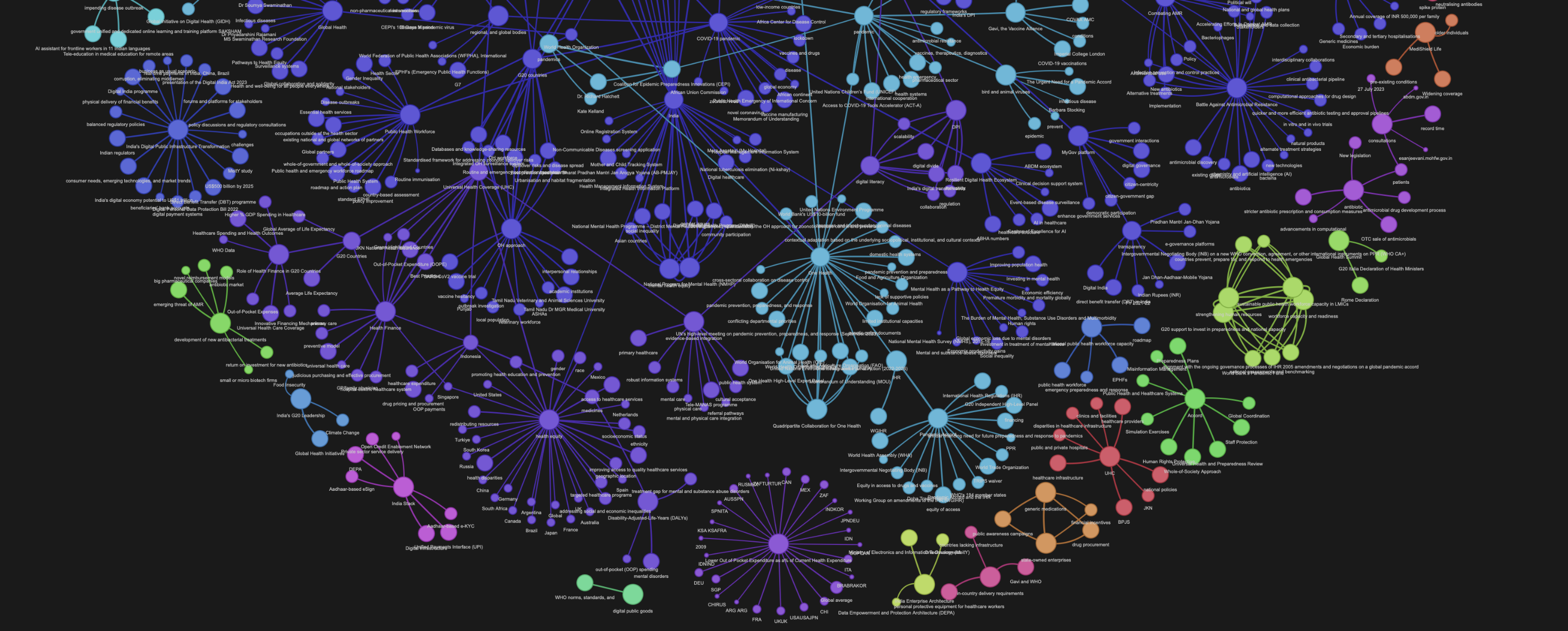 A knowledge graph generated using this code
ghpages link of this graph: https://rahulnyk.github.io/knowledge_graph/
A knowledge graph generated using this code
ghpages link of this graph: https://rahulnyk.github.io/knowledge_graph/
A knowledge graph, also known as a semantic network, represents a network of real-world entities—i.e. objects, events, situations, or concepts—and illustrates the relationship between them. This information is usually stored in a graph database and visualized as a graph structure, prompting the term knowledge “graph.”
Source: https://www.ibm.com/topics/knowledge-graph
- Clean the text corpus (The body of work).
- Extract concepts and entities from the body of work.
- Extract relations between the entities.
- Convert a graph schema.
- Populate nodes (concepts) and edges (relations).
- Visualise and Query.
Step 6 is purely optional, but it has certain artistic gratification associated with it. Network graphs are beautiful objects (just look at the banner image above, isn't it beautiful?). Fortunately, there are a good number of Python libraries available for generating graph visualisations.
Once the Knowledge Graph (KG) is build, we can use it for many purposes. We can run graph algorithms and calculate centralities of any node, to understand how important a concept (node) is to this body of work. We can calculate communities to bunch the concepts together to better analyse the text. We can understand the connectedness between seemingly disconnected concepts.
The best of all, we can achieve Graph Retrieval Augmented Generation (GRAG) and chat with our text in a much more profound way using Graph as a retriever. This is a new and improved version of Retrieval Augmented Generation (RAG) where we use a vectory db as a retriever to chat with our documents.
Here I have created a simple knowledge graph from a PDF document. The process I follow here is very similar to what is outlined in the above sections, with some simplifications.
First I split the entire text into chunks. Then I extract concepts mentioned within each chunk using an LLM. Note that I am not extracting entities using an NER model here. There is a difference between concepts and entities. For example 'Bangalore' is an entity, and 'Pleasant weather in Bangalore' is a concept. In my experience, concepts make more meaningful KG than entities.
I assume that the concepts that are mentioned in the vicinity of each other are related. So every edge in the KG is a text chunk in which the two connected concepts are mentioned.
Once the nodes (concepts) and the edges (text chunks) are calculated, It is easy to create a graph out of them using the libraries mentioned here. All the components I used here are set up locally, so this project can be run very easily on a personal machine. I have adopted a no-GPT approach here to keep things economical. I am using the fantastic Mistral 7B openorca instruct, which crushes this use case wonderfully. The model can be set up locally using Ollama so generating the KG is basically free (No calls to GPT).
To generate a graph there are two notebooks you need to tweak.
-
extract_concepts.ipynb: This notebook loads the documents, splits them up into chunks of text, and extracts concepts from each chunk. It outputs two CSV files in the data_output directory.
-
concept_graph.ipynb: This notebook reads the csv files, and creates a graph out of them. I am also calculating the graph communities here for colouring the nodes community-wise. That's how the graph in the banner image is so colourful. The notebook also generates the pyvis graph visualisation.
I am using the Mistral 7B Openorca for extracting concepts out of text chunks. It can follow the system prompt instructions very well.
Ollama makes it easy to host any model locally. Mistral 7B OpenOrca version is already available with Ollama to use out of the box.
dataframes for graph schema (can use a graphdb at a later stage).
This is a python library that makes dealing with graphs super easy
Pyvis python library for visualisation. Pyvis generates Javascript Graph visualisations using python, so the final graphs can be hosted on the web. For example the github link of this repo is a graph generated by pyvis

